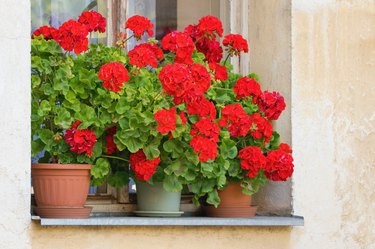
Common garden geraniums (Pelargonium spp.) are timeless and easy-to-grow flowering tender perennials that are typically cultivated as annuals in cool climates. Yellow geranium leaves are an indication that the plants need more nitrogen, which is why properly fertilizing these plants is essential. The frequency of fertilizer applications will depend on whether you are growing geraniums in containers or in garden beds. Geraniums are considered winter hardy in U.S. Department of Agriculture zones 10 and 11.
Characteristics of Geraniums
Video of the Day
There are more than 200 species in the genus Pelargonium, which is a different group of plants than "true" geraniums, and they are more common in gardens. One of the most popular Pelargonium varieties is the hybrid known as "busy Lizzie" or zonal geranium (Pelargonium × hortorum), which comes in a range of shades of red, pink and orange as well as white and purple. The regal geranium (Pelargonium × domesticum), also referred to as the Martha Washington geranium, is another common variety of garden geranium.
Video of the Day
Geranium flowers grow in clusters known as umbels. Geranium plants usually range in height from 1 to 3 feet. They are well suited for growing outdoors in garden beds; however, they also work well in containers, such as window boxes and hanging baskets.
When choosing a spot for your geraniums, you want to be sure to situate them where they will receive at least six hours of sunlight a day, which will produce the best flowering. Deadheading the plants, which means removing the spent leaves, can encourage geranium plants to re-bloom.
Best Fertilizer for Geraniums
Geraniums often need to be fertilized to thrive. If you are growing geraniums in a garden bed outdoors, a soil test is recommended to determine what nutrients may be missing from the soil. Generally, incorporating a pound of 10-20-10 fertilizer for every 100 square feet prior to planting will provide enough nutrients for geraniums at the onset. You should plan to continue fertilizing the geraniums plants every four to six weeks during the growing season with a water-soluble formula in order to keep them looking their best.
Geraniums in containers generally need more fertilizer than those that are cultivated in garden beds, as the plants use up the nutrients in the potting soil quicker. A balanced 10-10-10 fertilizer works well for container-grown geraniums. Apply diluted fertilizer every two weeks. If you are growing geraniums indoors year-round, only fertilize the plants in the spring and summer when they are actively growing.
Common Geranium Problems
Yellow leaves on geraniums are an indication that the plants are not receiving enough nitrogen, which means that you may not be fertilizing the plants often enough. It is just as important not to overfertilize geraniums, however, as this can result in excessive foliage at the expense of flower production.
Geraniums require well-drained soil but should be watered frequently, allowing the soil to dry out between waterings. Yellowing geranium leaves can also occur when the plant does not receive enough moisture. Too much water can also be problematic, however, and can result in root and stem rot. When watering geraniums, you should avoid getting the leaves wet, which can lead to unsightly leaf spot diseases.